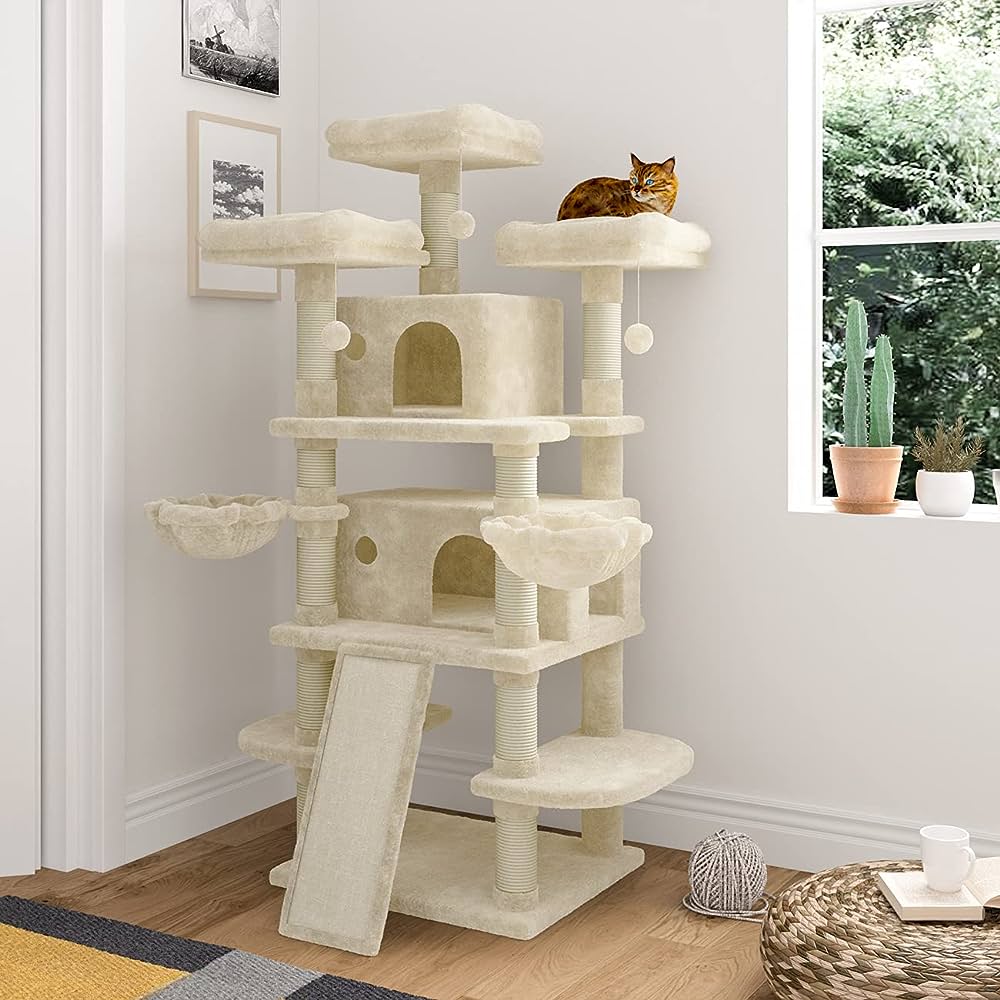
Safety is of utmost importance when it comes to cat trees for large cats. There are several key safety measures that should be considered during the design, construction, and maintenance of these cat trees. These measures include secure anchoring, the use of non-toxic materials, ensuring smooth surfaces, and conducting regular maintenance.
First and foremost, secure anchoring is crucial to prevent any instability or tipping of the cat tree. Large cats are naturally more powerful and can exert significant force on the structure. Properly securing the cat tree to the floor or wall ensures its stability, reducing the risk of accidents or injuries.
Additionally, the materials used in the construction of the cat tree should be non-toxic and safe for cats. This includes the choice of wood, fabrics, and adhesives. Using materials that are free from harmful chemicals or toxins ensures the well-being of the cats and minimizes any potential health risks.
Smooth surfaces are also important for the safety of large cats. Cats love to climb and explore, and rough or jagged surfaces can cause injuries or discomfort. Ensuring that all surfaces, including platforms and scratching posts, are smooth and free from any sharp edges or protrusions is essential.
Ensuring Cat Trees are Securely Anchored to Prevent Tipping
One of the most important safety measures for large cat trees is to ensure that they are securely anchored in order to prevent tipping. In the case that a cat tree is not properly secured, large cats can exert significant force on the structure, potentially causing instability. Anchoring the cat tree to the wall or ceiling is recommended, especially when it’s floor-to-ceiling. Use brackets, tension rods, or strong screws to firmly attach the cat tree to the chosen anchor points. Regularly check the stability of the cat tree and tighten any loose connections. By implementing secure anchoring, owners can prevent accidents and provide a safe environment for their large cats to climb, explore, and play.
Using Non-Toxic Materials for Cat Trees for Large Cats
When designing or purchasing cat trees for large cats, it is crucial to prioritize the use of non-toxic materials. Large cats may be inclined to chew or scratch on different parts of the cat tree, and toxic materials can pose a significant health risk. Opt for cat trees made from natural, pet-friendly materials such as solid wood, sisal rope, or non-toxic carpeting. Avoid using materials treated with harmful chemicals or paints that could be ingested by the cat. It is also essential to choose adhesives and sealants that are non-toxic and safe for feline use. By using non-toxic materials, owners can ensure the safety and well-being of their large cats.
Choosing Cat Trees with Smooth Surfaces to Avoid Injury
Smooth surfaces on cat trees are essential to prevent injuries to large cats. Avoid cat trees with rough or splintered surfaces that could cause cuts or abrasions. Check that all edges and corners are smooth, without any sharp or protruding parts that could pose a risk. Ensure that platforms and perches have carpeting or padding to provide a comfortable and non-slip surface. For cat trees with scratching posts, make sure that the materials used for the posts are not rough or abrasive to prevent any potential harm to the cat’s paws. Choosing cat trees with smooth surfaces reduces the risk of injuries and maintains a safe environment for large cats.
Regularly Inspecting and Maintaining Cat Trees for Large Cats
Regular inspection and maintenance are vital to ensure the ongoing safety of cat trees for large cats. Set a routine for checking the cat tree, including examining the stability of the structure, inspecting all connections, and looking for any signs of wear or damage. Replace any worn-out or frayed scratching surfaces, such as sisal rope or carpeting, to prevent cats from getting entangled or injured. Tighten any loose screws or connections and reinforce weak areas as needed. Regularly clean the cat tree to remove dirt, debris, or potential hazards. By conducting regular inspections and maintenance, owners can identify and address safety concerns promptly, providing a secure and hazard-free environment for their large cats.